Timeline of the 2015 Atlantic hurricane season
The 2015 Atlantic hurricane season was an event in the annual hurricane season in the north Atlantic Ocean. It was the third consecutive year to feature below-average tropical cyclone activity,[nb 1] with eleven named storms. The season officially began on June 1, 2015 and ended on November 30, 2015. These dates, adopted by convention, historically describe the period in each year when most tropical systems form.[2] However, systems can and do form outside these dates, as did the season's first storm, Tropical Storm Ana, which developed on May 8; the season's final storm, Hurricane Kate, lost its tropical characteristics on November 11.
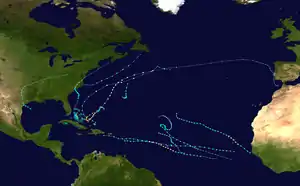
The year featured twelve tropical cyclones, of which eleven became tropical storms, including four hurricanes of which two intensified into major hurricanes.[nb 2] While no hurricanes made landfall on the United States mainland during the year, two tropical storms, Ana and Bill, struck the coastline of South Carolina and Texas respectively. Ana was earliest landfalling tropical storm on record in the United States and caused two fatalities, while Bill produced heavy rain and flooding and caused eight fatalities. Additionally, the precursor to Bill also caused significant flooding across Central America. In October, Hurricane Joaquin, a Category 4 hurricane, battered The Bahamas for two days, causing extensive devastation to that nation while also contributing to historic flooding across the Southeastern United States. Following the 2014 season, the name Joaquin was retired from reuse in the North Atlantic by the World Meteorological Organization.[4]
This timeline documents tropical cyclone formations, strengthening, weakening, landfalls, extratropical transitions, and dissipations during the season. It includes information that was not released throughout the season, meaning that data from post-storm reviews by the National Hurricane Center, such as a storm that was not initially warned upon, has been included.
By convention, meteorologists one time zone when issuing forecasts and making observations: Coordinated Universal Time (UTC), and also use the 24-hour clock (where 00:00 = midnight UTC).[5] In this time line, all information is listed by UTC first with the respective local time included in parentheses.
Timeline

May
May 8
- 00:00 UTC (8:00 p.m. EDT, May 7) – Subtropical Storm Ana develops about 175 mi (280 km)[nb 3] south-southeast of Myrtle Beach, South Carolina.[6]
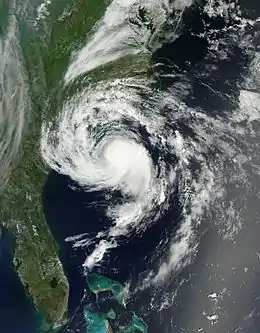
May 9
- 00:00 UTC (8:00 p.m. EDT, May 8) – Subtropical Storm Ana attains its peak intensity with maximum sustained winds of 60 mph (95 km/h) and a minimum barometric pressure of 998 mb (hPa; 29.47 inHg) roughly 150 mi (240 km) southeast of Myrtle Beach, South Carolina.[6]
- 06:00 UTC (2:00 a.m. EDT) – Subtropical Storm Ana transitions into a fully tropical cyclone about 130 mi (210 km) southeast of Myrtle Beach, South Carolina.[6]
May 10
- 10:00 UTC (6:00 a.m. EDT) – Tropical Storm Ana makes landfall near North Myrtle Beach, South Carolina with winds of 45 mph, becoming the earliest United States landfalling tropical cyclone on record.[6]
- 18:00 UTC (2:00 p.m. EDT) – Tropical Storm Ana weakens to a tropical depression roughly 45 mi (75 km) west-southwest of Wilmington, North Carolina.[6]
May 12
- 00:00 UTC (8:00 p.m. EDT, May 11) – Tropical Depression Ana degenerates into a non-convective remnant area of low pressure about 15 mi (25 km) south of Ocean City, Maryland.[6]
June
June 1
- The 2015 Atlantic hurricane season officially begins.[2]
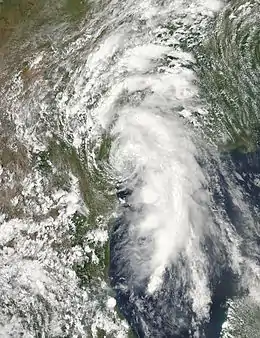
June 16
- 00:00 UTC (7:00 p.m. CDT, June 15) – Tropical Storm Bill develops about 200 mi (320 km) east-southeast of Corpus Christi, Texas.[7]
- 12:00 UTC (7:00 a.m. CDT) – Tropical Storm Bill attains its peak intensity with maximum sustained winds of 60 mph (95 km/h) and a minimum barometric pressure of 997 mb (hPa; 29.44 inHg) roughly 85 miles (140 km) east-northeast of Corpus Christi, Texas.[7]
- 16:45 UTC (11:45 a.m. CDT) – Tropical Storm Bill makes landfall on Matagorda Island, Texas, with winds of 60 mph (95 km/h).[7]
June 17
- 06:00 UTC (1:00 a.m. CDT) – Tropical Storm Bill weakens to a tropical depression about 35 mi (55 km) east of Austin, Texas.[7]
June 18
- 18:00 UTC (1:00 p.m. CDT) – Tropical Depression Bill degenerates into a non-convective remnant area of low pressure roughly 75 mi (120 km) south-southeast of Tulsa, Oklahoma.[7]
July
July 13
- 06:00 UTC (2:00 a.m. AST – Tropical Depression Three develops about 280 mi (450 km) east-southeast of Virginia Beach, Virginia.[8]
- 12:00 UTC (8:00 a.m. AST) – Tropical Depression Three intensifies into Tropical Storm Claudette roughly 330 mi (530 km) southeast of Ocean City, New Jersey.[8]
- 18:00 UTC (2:00 p.m. AST) – Tropical Storm Claudette attains its peak intensity with maximum sustained winds of 50 mph (85 km/h) and a minimum barometric pressure of 1003 mb (hPa; 29.62 inHg) about 410 mi (660 km) southeast of New York, New York.[8]
July 15
- 00:00 UTC (8:00 p.m. AST, July 14) – Tropical Storm Claudette degenerates into a non-convective remnant area of low pressure roughly 245 mi (395 km) south-southwest of Saint-Pierre, Newfoundland.[8]
August
August 18
- 06:00 UTC (2:00 a.m. AST) – Tropical Depression Four develops roughly 740 mi (1,190 km) southwest of Brava, Cape Verde.[9]
- 12:00 UTC (8:00 a.m. AST) – Tropical Depression Four intensifies into Tropical Storm Danny approximately 810 mi (1,305 km) southwest of Brava, Cape Verde.[9]
August 20
- 12:00 UTC (8:00 a.m. AST) – Tropical Storm Danny intensifies into a Category 1 hurricane about 1,095 mi (1,760 km) east of Barbados.[9]
August 21

– Hurricane Danny intensifies into a Category 2 hurricane roughly 900 mi (1,450 km) east of Barbados.[9]
- 12:00 UTC (8:00 a.m. AST) – Hurricane Danny intensifies into a Category 3 hurricane and simultaneously attains its peak intensity with maximum sustained winds of 125 mph (205 km/h) and a minimum barometric pressure of 960 mb (hPa; 28.35 inHg) approximately 790 mi (1,270 km) east of Barbados.[9]
August 22
- 00:00 UTC (8:00 p.m. AST, August 21) – Hurricane Danny weakens to a Category 2 hurricane about 690 mi (1,110 km) east of Barbados.[9]
- 12:00 UTC (8:00 a.m. AST) – Hurricane Danny weakens to a Category 1 hurricane roughly 565 mi (910 km) east-northeast of Barbados.[9]
August 23
- 00:00 UTC (8:00 p.m. AST, August 22) – Hurricane Danny weakens to a tropical storm approximately 405 mi (650 km) northeast of Barbados.[9]
August 24
- 12:00 UTC (8:00 a.m. AST) – Tropical Storm Danny weakens to a tropical depression about 15 mi (25 km) north of Dominica.[9]
- 18:00 UTC (2:00 p.m. AST) – Tropical Depression Danny degenerates into a trough of low pressure over the extreme northeastern Caribbean Sea.[9]
August 25
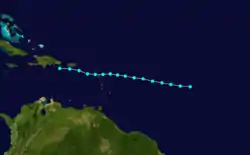
- 03:00 UTC (11:00 p.m. AST August 24) – Tropical Storm Erika develops about 955 mi (1,535 km) east of the Leeward Islands.[10]
August 27
- 09:00 UTC (5:00 a.m. AST) – Tropical Storm Erika attains its peak intensity with maximum sustained winds of 50 mph (85 km/h) and a minimum barometric pressure of 1003 mb (hPa; 29.63 inHg) roughly 35 mi (55 km) north of Guadeloupe.[11]
August 29
- 13:30 UTC (9:30 a.m. EDT) – Tropical Storm Erika degenerates into a trough of low pressure about 130 mi (205 km) east of Camagüey, Cuba.[12]
August 30
- 00:00 UTC (8:00 p.m. AST, August 29) – Tropical Depression Six develops roughly 300 mi (485 km) west-northwest of Conakry, Africa.[13]
- 06:00 UTC (2:00 a.m. AST) – Tropical Depression Six intensifies into Tropical Storm Fred approximately 370 mi (595 km) northwest of Conakry, Africa.[13]
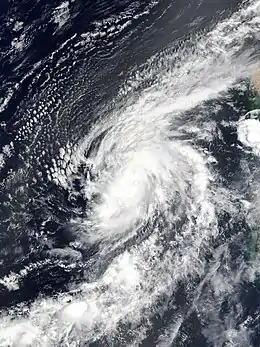
August 31
- 00:00 UTC (8:00 p.m. AST, August 30) – Tropical Storm Fred intensifies into a Category 1 hurricane about 165 mi (265 km) south-southeast of Sal, Cape Verde.[13]
- 12:00 UTC (8:00 a.m. AST) – Hurricane Fred attains its peak intensity with maximum sustained winds of 85 mph (140 km/h) and a minimum barometric pressure of 986 mb (hPa; 29.12 inHg) roughly 50 mi (85 km) south-southwest of Sal, Cape Verde.[13]
September
September 1
- 06:00 UTC (2:00 a.m. AST) – Hurricane Fred weakens to a tropical storm about 55 mi (90 km) north-northwest of Santo Antão, Cape Verde.[13]
September 4
- 12:00 UTC (8:00 a.m. AST) – Tropical Storm Fred weakens to a tropical depression roughly 1,245 mi (2,005 km) southwest of the Azores.[13]
September 5
- 00:00 UTC (8:00 p.m. AST, September 4) – Tropical Depression Fred re-intensifies into a tropical storm about 1,265 mi (2,035 km) southwest of the Azores.[13]
- 06:00 UTC (2:00 a.m. AST) – Tropical Depression Seven develops from an area of low pressure roughly 175 mi (280 km) south of the Cape Verde Islands.[14]
- 12:00 UTC (8:00 a.m. AST) – Tropical Storm Fred weakens to a tropical depression for a second time about 1,295 mi (2,085 km) southwest of the Azores.[13]
- 18:00 UTC (2:00 p.m. AST) – Tropical Depression Seven intensifies into Tropical Storm Grace about 185 mi (300 km) south-southwest of the Cape Verde Islands.[14]
September 6
- 12:00 UTC (8:00 a.m. AST) – Tropical Storm Grace attains its peak intensity with maximum sustained winds of 60 mph (95 km/h) and a minimum barometric pressure of 1000 mb (hPa; 29.53 inHg) roughly 335 mi (540 km) southwest of the Cape Verde Islands.[14]
- 18:00 UTC (2:00 p.m. AST) – Tropical Depression Fred degenerates into a trough of low pressure approximately 1,210 mi (1,945 km) southwest of the Azores.[13]
September 8
- 12:00 UTC (8:00 a.m. AST) – Tropical Storm Grace weakens to a tropical depression roughly 1,150 mi (1,850 km) west of the Cape Verde Islands.[14]
- 18:00 UTC (2:00 p.m. AST) – Tropical Depression Eight develops roughly 215 mi (345 km) southeast of Bermuda.[15]
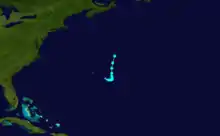
September 9
- 00:00 UTC (8:00 p.m. AST, September 8) – Tropical Depression Eight intensifies into Tropical Storm Henri about 220 mi (355 km) southeast of Bermuda.[15]
- 12:00 UTC (8:00 a.m. AST) – Tropical Depression Grace degenerates into a trough about 750 mi (1,205 km) east of the Lesser Antilles.[14]
- 18:00 UTC (2:00 p.m. AST) – Tropical Storm Henri attains its peak intensity with maximum sustained winds of 50 mph (85 km/h) and a minimum barometric pressure of 1003 mb (hPa; 29.62 inHg) roughly 250 mi (400 km) east-southeast of Bermuda.[15]
September 11
- 12:00 UTC (8:00 a.m. AST) – Tropical Storm Henri degenerates into a trough well north of Bermuda.[15]
September 16
- 12:00 UTC (8:00 a.m. AST) – Tropical Depression Nine develops from an area of low pressure roughly 1,265 mi (2,035 km) west of the Cape Verde Islands.[16]
September 17
- 06:00 UTC (2:00 a.m. AST) – Tropical Depression Nine attains its peak intensity with maximum sustained winds of 35 mph (55 km/h) and a minimum barometric pressure of 1006 mb (hPa; 29.71 inHg) about 1,060 mi (1,705 km) east of the Lesser Antilles.[16]
September 18
- 06:00 UTC (2:00 a.m. AST) – Tropical Depression Ten develops roughly 750 mi (1,205 km) west of the southernmost Cape Verde Islands.[17]
September 19
- 00:00 UTC (8:00 p.m. AST, September 18) – Tropical Depression Ten intensifies into Tropical Storm Ida about 845 mi (1,360 km) west-southwest of the southernmost Cape Verde Islands.[17]
- 18:00 UTC (2:00 p.m. AST) – Tropical Depression Nine dissipates roughly 805 mi (1,295 km) east of the northern Leeward Islands.[16]
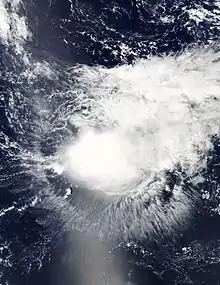
September21
- 06:00 UTC (2:00 a.m. AST) – Tropical Storm Ida attains maximum sustained winds of 50 mph (85 km/h) about 950 mi (1,530 km) northeast of the northern Lesser Antilles.[17]
- 12:00 UTC (8:00 a.m. AST) – Tropical Storm Ida attains a minimum barometric pressure of 1001 mb (hPa; 29.56 inHg) roughly 910 mi (1,465 km) northeast of the northern Lesser Antilles.[17]
September 24
- 06:00 UTC (2:00 a.m. AST) – Tropical Storm Ida weakens to a tropical depression roughly 1,060 mi (1,705 km) east-northeast of the northern Lesser Antilles.[17]
September 27
- 12:00 UTC (8:00 a.m. AST) – Tropical Depression Ida degenerates into a non-convective remnant area of low pressure about 1,235 mi (1,990 km) northeast of San Juan, Puerto Rico.[17]
September 28
- 00:00 UTC (8:00 p.m. AST, September 27) – Tropical Depression Eleven develops from an area of low pressure roughly 415 mi (670 km) northeast of San Salvador Island, Bahamas.[18]
September 29
- 00:00 UTC (8:00 p.m. EDT, September 28) – Tropical Depression Eleven intensifies into Tropical Storm Joaquin about 340 mi (545 km) northeast of San Salvador Island, Bahamas.[18]
September 30
- 06:00 UTC (2:00 a.m. EDT) – Tropical Storm Joaquin intensifies into a Category 1 hurricane roughly 195 mi (315 km) east-northeast of San Salvador Island, Bahamas.[18]
October
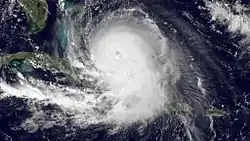
October 1
- 00:00 UTC (8:00 p.m. EDT, September 30) – Hurricane Joaquin intensifies into a Category 3 hurricane about 105 mi (165 km) east of San Salvador Island, Bahamas.[18]
- 12:00 UTC (8:00 a.m. EDT) – Hurricane Joaquin intensifies into a Category 4 hurricane and makes its first landfall on Samana Cay, Bahamas, with winds of 135 mph (215 km/h).[18]
October 2
- 00:00 UTC (8:00 p.m. EDT, October 1) – Hurricane Joaquin attains a minimum barometric pressure of 931 mb (hPa; 27.50 inHg) roughly 5 mi (10 km) northwest of Crooked Island, Bahamas.[18]
- 16:00 UTC (12:00 p.m. EDT) – Hurricane Joaquin weakens to a Category 3 hurricane and makes its second landfall on Rum Cay, Bahamas, with winds of 125 mph (205 km/h).[18]
- 21:00 UTC (5:00 p.m. EDT) – Hurricane Joaquin makes its third landfall on San Salvador Islands, Bahamas, with winds of 125 mph (205 km/h).[18]
October 3
- 00:00 UTC (8:00 p.m. EDT, October 2) – Hurricane Joaquin re-intensifies into a Category 4 hurricane about 15 mi (35 km) north-northeast of San Salvador Island, Bahamas.[18]
- 12:00 UTC (8:00 a.m. EDT) – Hurricane Joaquin attains its peak intensity with maximum sustained winds of 155 mph (250 km/h) roughly 145 mi (235 km) northeast of San Salvador Island, Bahamas.[18]
October 4
- 06:00 UTC (2:00 a.m. EDT) – Hurricane Joaquin weakens to a Category 3 hurricane about 310 mi (500 km) south-southwest of Bermuda.[18]
- 12:00 UTC (8:00 a.m. EDT) – Hurricane Joaquin weakens to a Category 2 hurricane roughly 190 mi (305 km) south-southwest of Bermuda.[18]
October 5
- 00:00 UTC (8:00 p.m. EDT, October 4) – Hurricane Joaquin weakens to a Category 1 hurricane about 70 mi (110 km) west-northwest of Bermuda.[18]
October 7
- 12:00 UTC (8:00 a.m. EDT) – Hurricane Joaquin weakens to a tropical storm roughly 480 mi (770 km) southeast of Cape Race, Newfoundland.[18]
October 8
- 00:00 UTC (8:00 p.m. EDT, October 7) – Tropical Storm Joaquin transitions into an extratropical storm about 445 mi (715 km) west-northwest of the Azores.[18]
November
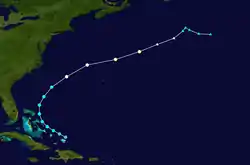
November 8
- 18:00 UTC (1:00 p.m. EST) – Tropical Depression Twelve develops about 55 mi (90 km) north-northwest of Cockburn Town, Turks and Caicos Islands.[19]
November 9
- 06:00 UTC (1:00 a.m. EST) – Tropical Depression Twelve intensifies into Tropical Storm Kate roughly 50 mi (85 km) north of Crooked Island, Bahamas.[19]
November 11
- 00:00 UTC (7:00 p.m. EST, November 10) – Tropical Storm Kate intensifies into a Category 1 hurricane about 390 mi (630 km) east-southeast of Wilmington, North Carolina.[19]
- 12:00 UTC (7:00 a.m. AST) – Hurricane Kate attains its peak intensity with maximum sustained winds of 85 mph (140 km/h) and a minimum barometric pressure of 980 mb (hPa; 28.94 inHg) roughly 320 mi (515 km) northeast of Bermuda.[19]
November 12
- 00:00 UTC (7:00 p.m. AST, November 11) – Hurricane Kate transitions into an extratropical cyclone about 735 mi (1,185 km) northeast of Bermuda.[19]
November 30
- The 2015 Atlantic hurricane season officially ends.[2]
See also
Notes
- An average Atlantic hurricane season, as defined by the National Oceanic and Atmospheric Administration, has 12 tropical storms, six hurricanes and two major hurricanes.[1]
- Hurricanes reaching Category 3 (111 miles per hour (179 km/h)) and higher on the 5-level Saffir–Simpson wind speed scale are considered major hurricanes.[3]
- The figures for maximum sustained winds and position estimates are rounded to the nearest 5 units (knots, miles, or kilometers), following the convention used in the National Hurricane Center's operational products for each storm. All other units are rounded to the nearest digit.
References
- "Background Information: North Atlantic Hurricane Season". College Park, Maryland: NOAA Climate Prediction Center. Retrieved July 23, 2020.
- Dorst, Neal (June 1, 2018). "Hurricane Season Information". Frequently Asked Questions About Hurricanes. Miami, Florida: NOAA Atlantic Oceanographic and Meteorological Laboratory. Retrieved June 29, 2020.
- "Saffir-Simpson Hurricane Wind Scale". Miami, Florida: National Hurricane Center. Retrieved July 23, 2020.
- "Tropical Cyclone Naming History and Retired Names". miami, Florida: NOAA National Hurricane Center. Retrieved July 23, 2020.
- "Understanding the Date/Time Stamps". miami, Florida: NOAA National Hurricane Center. Retrieved July 14, 2020.
- Stewart, Stacy R. (September 15, 2015). Tropical Cyclone Report: Tropical Storm Ana (PDF) (Report). Miami, Florida: National Hurricane Center. Retrieved December 9, 2015.
- Berg, Robbie J. (September 9, 2015). Tropical Cyclone Report: Tropical Storm Bill (PDF) (Report). Miami, Florida: National Hurricane Center. Retrieved October 5, 2015.
- Avila, Lixion A. (August 14, 2015). Tropical Cyclone Report: Tropical Storm Claudette (PDF) (Report). Miami, Florida: National Hurricane Center. Retrieved October 6, 2015.
- Stewart, Stacy R. (January 19, 2016). Tropical Cyclone Report: Hurricane Danny (PDF) (Report). Miami, Florida: National Hurricane Center. Retrieved January 21, 2016.
- Brown, Daniel P. (August 24, 2015). "Tropical Storm Erika Public Advisory Number 1". Miami, Florida: NWS National Hurricane Center. Retrieved July 23, 2020.
- Brennan, Michael J. (August 27, 2015). "Tropical Storm Erika Public Advisory Number 10". Miami, Florida: NWS National Hurricane Center. Retrieved July 23, 2020.
- Beven, John L. (August 29, 2015). "Tropical Storm Erika Special Advisory Number 19". Miami, Florida: NWS National Hurricane Center. Retrieved July 23, 2020.
- Beven, John L. (January 20, 2016). Tropical Cyclone Report: Hurricane Fred (PDF) (Report). Miami, Florida: National Hurricane Center. Retrieved January 21, 2016.
- Blake, Eric S. (November 21, 2015). Tropical Cyclone Report: Tropical Storm Grace (PDF) (Report). Miami, Florida: National Hurricane Center. Retrieved December 10, 2015.
- Kimberlain, Todd B. (October 21, 2015). Tropical Cyclone Report: Tropical Storm Henri (PDF) (Report). Miami, Florida: National Hurricane Center. Retrieved December 10, 2015.
- Brown, Daniel P. (November 16, 2015). Tropical Cyclone Report: Tropical Depression Nine (PDF) (Report). Miami, Florida: National Hurricane Center. Retrieved December 10, 2015.
- Cangialosi, John P. (November 7, 2015). Tropical Cyclone Report: Tropical Storm Ida (PDF) (Report). Miami, Florida: National Hurricane Center. Retrieved December 10, 2015.
- Berg, Robbie J. (January 12, 2016). Tropical Cyclone Report: Hurricane Joaquin (PDF) (Report). Miami, Florida: National Hurricane Center. Retrieved January 19, 2016.
- Avila, Lixion A. (January 4, 2016). Tropical Cyclone Report: Hurricane Kate (PDF) (Report). Miami, Florida: National Hurricane Center. Retrieved January 19, 2016.
External links
| Wikimedia Commons has media related to 2015 Atlantic hurricane season. |
